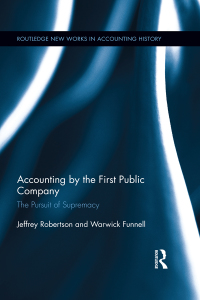IT Project Management Assignment One,please help to write project charter., Thanks !
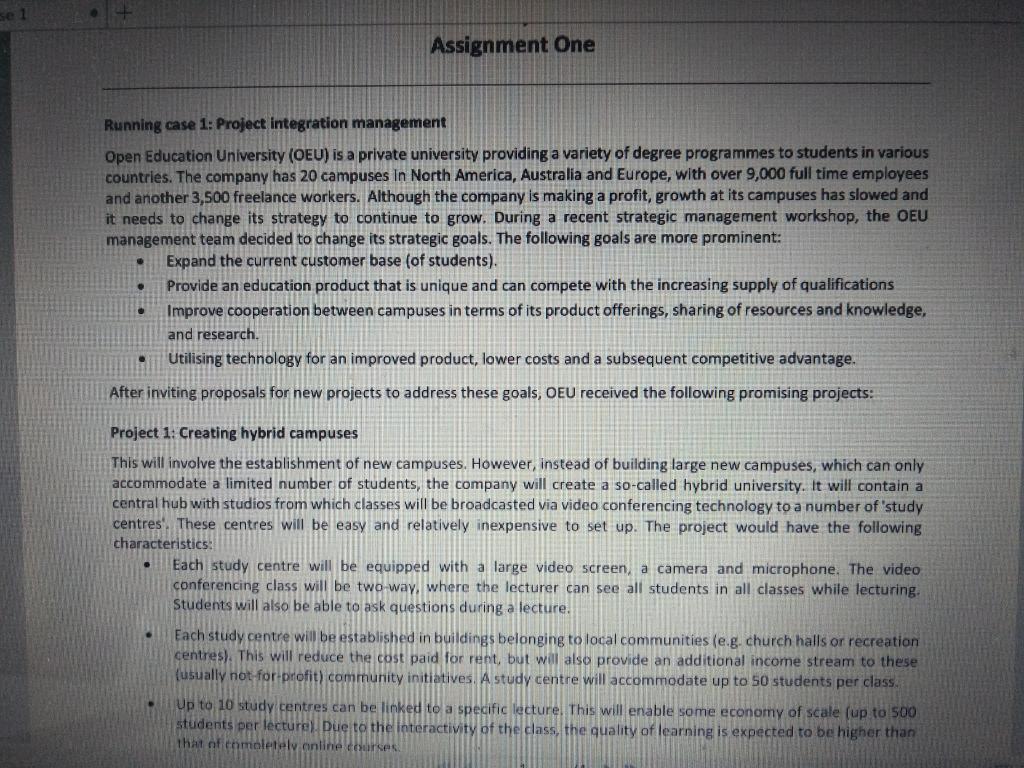
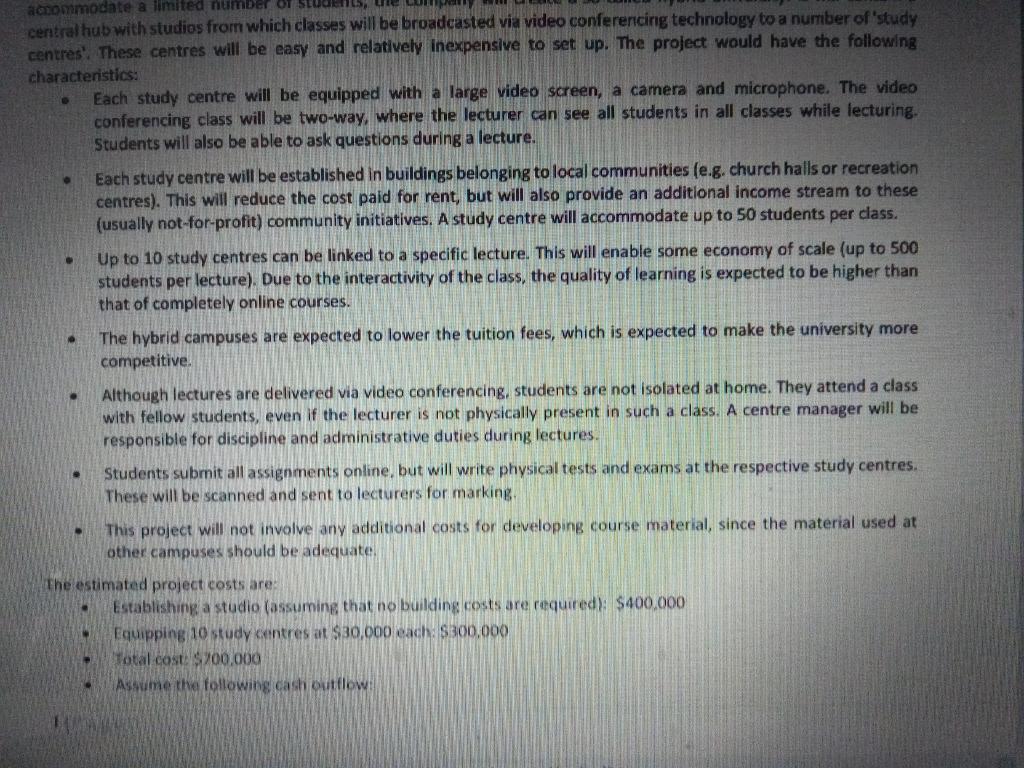

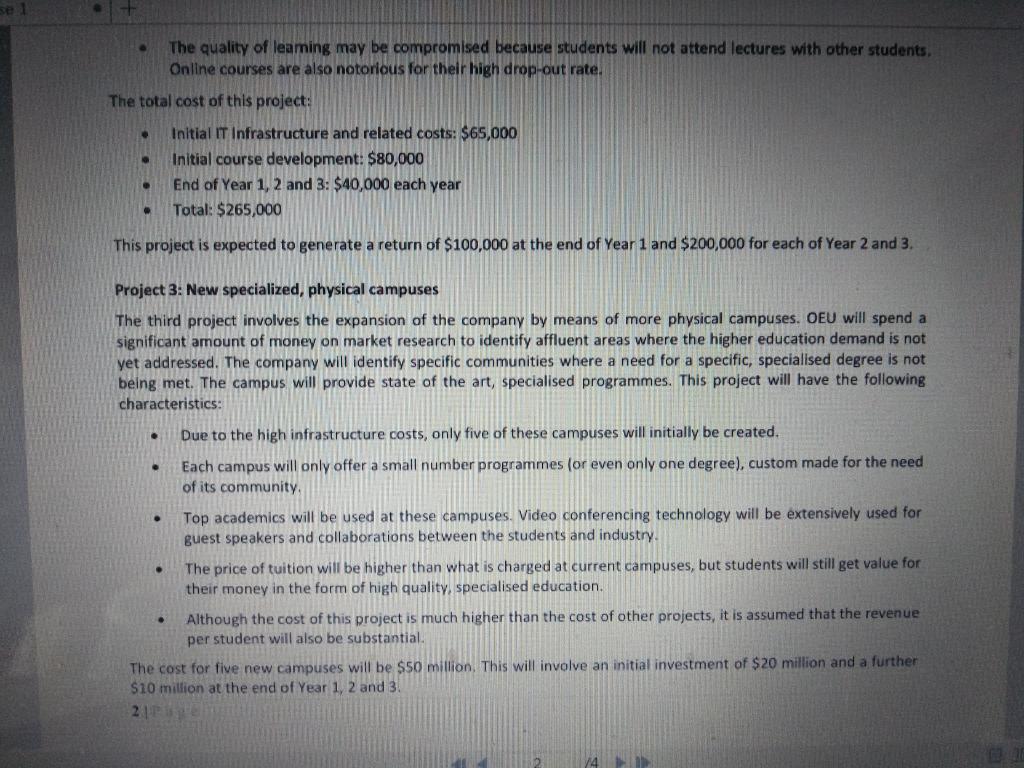

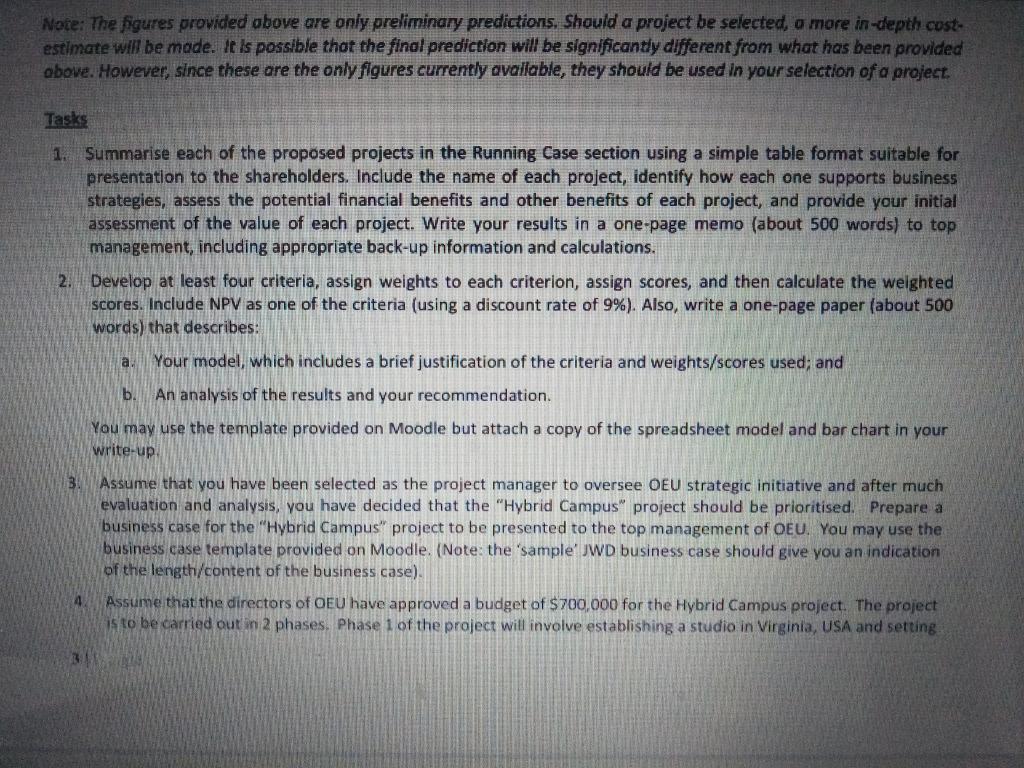

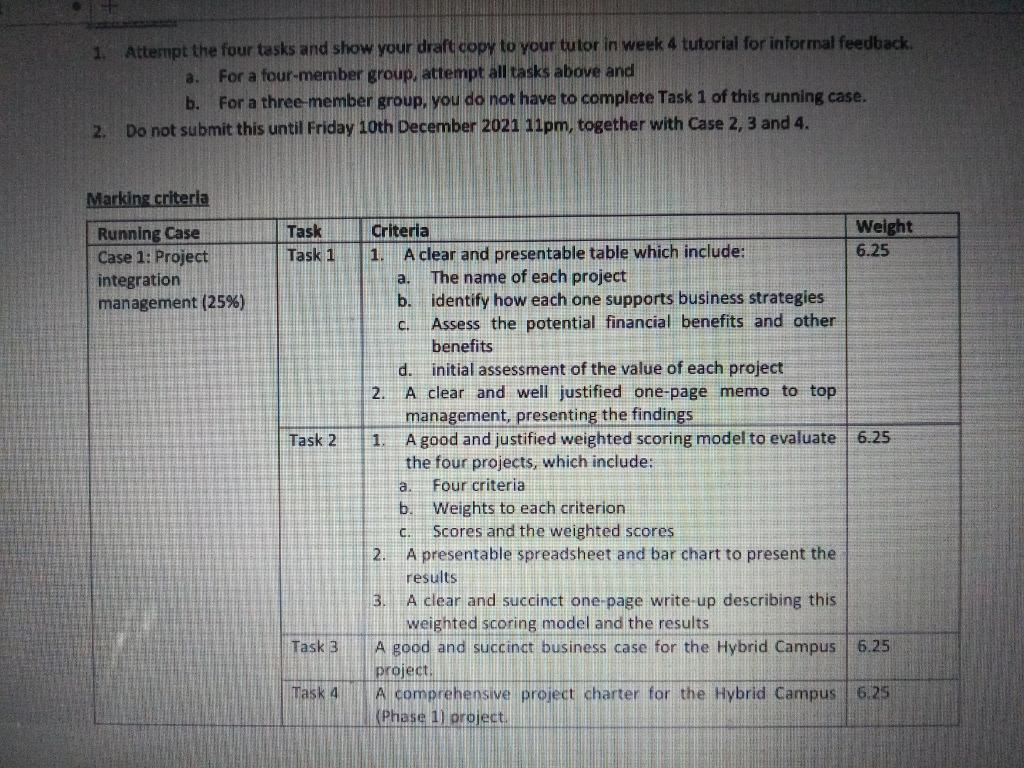
Task
Assume that the directors of OEU have approved a budget of $700,000 for the Hybrid Campus project. The project is to be carried out in 2 phases. Phase 1 of the project will involve establishing a studio in Virginia, USA and setting up 2 study centres (one in Prato, Italy and the other in Melbourne, Australia). This is estimated to take one year. Prepare a project charter for the Hybrid Campus (Phase 1) project. You may use the project charter template provided on Moodle.
Project 1: Creating hybrid campuses
-
The estimated project costs are:
-
Establishing a studio (assuming that no building costs are required): $400,000
-
Equipping 10 study centres at $30,000 each: $300,000
-
Total cost: $700,000
-
Assume the following cash outflow:
o Beginning of first year: $200,000 o End of first year: $260,000 o End of second and third year: $120,000 each
The estimated financial benefit from the project: $200,000 end of first year, $500,000 end of second year and $750,000 at the end of third year.
Project 2: Expand online
-
The total cost of this project:
-
Initial IT Infrastructure and related costs: $65,000
-
Initial course development: $80,000
-
End of Year 1, 2 and 3: $40,000 each year
-
Total: $265,000
This project is expected to generate a return of $100,000 at the end of Year 1 and $200,000 for each of Year 2 and 3.
-
Project 3: New specialized, physical campuses
-
The cost for five new campuses will be $50 million. This will involve an initial investment of $20 million and a further $10 million at the end of Year 1, 2 and 3.
The benefit is expected to be substantial and estimated to be in the order of about $10 million at the end of the first year and $40 million in each of the next 2 years.
Project 4: Upgrade current campuses
The cost for this project is:
-
IT upgrades for 20 campuses: $1,000,000
-
Upgrading lecture room capacity at 20 campuses: $4,400,000
-
Total: $5,400,000
This will involve an initial investment of $2.4 million and a further $1 million at the end of Year 1, 2 and 3. It is expected that this project will lead to an increase of 60% in revenue if all campuses are filled to their capacity. So, this is expected to bring in a revenue of about $2 million by the end of the first year and a further $1 million increase in each of the next 2 years.
Assignment One Running case 1: Project integration management Open Education University (OEU) is a private university providing a variety of degree programmes to students in various countries. The company has 20 campuses in North America, Australia and Europe, with over 9,000 full time employees and another 3,500 freelance workers. Although the company is making a profit, growth at its campuses has slowed and it needs to change its strategy to continue to grow. During a recent strategic management workshop, the OEU management team decided to change its strategic goals. The following goals are more prominent: Expand the current customer base (of students). Provide an education product that is unique and can compete with the increasing supply of qualifications Improve cooperation between campuses in terms of its product offerings, sharing of resources and knowledge, and research. Utilising technology for an improved product, lower costs and a subsequent competitive advantage. After inviting proposals for new projects to address these goals, OEU received the following promising projects: Project 1: Creating hybrid campuses his involve the establishment of new campuses. However, instead of building large new campuses, which can only accommodate a limited number of students, the company will create a so-called hybrid university. It will contain a central hub with studios from which classes will be broadcasted via video conferencing technology to a number of study centres. These centres will be easy and relatively inexpensive to set up. The project would have the following characteristics: Each study centre will be equipped with a large video screen, a camera and microphone. The video conferencing class will be two way, where the lecturer can see all students in all classes while lecturing. Students will also be able to ask questions during a lecture. Each study centre will be established in buildings belonging to local communities (e.g. church halls or recreation centres). This will reduce the cost paid for rent, but will also provide an additional income stream to these (usually not for-profit) community initiatives. A study centre will accommodate up to 50 students per class. Up to 10 study centres can be linked to a specific lecture. This will enable some economy of scale (up to 500 students per lecturel Due to the Interactivity of the dass, the quality of learning is expected to be higher than that nehmoletely online courses . . . acommodate a limited number on central hub with studios from which classes will be broadcasted via video conferencing technology to a number of 'study centres'. These centres will be easy and relatively inexpensive to set up. The project would have the following characteristics: Each study centre will be equipped with a large video screen, a camera and microphone. The video conferencing class will be two-way, where the lecturer can see all students in all classes while lecturing. Students will also be able to ask questions during a lecture. Each study centre will be established in buildings belonging to local communities (e.g. church halls or recreation centres). This will reduce the cost paid for rent, but will also provide an additional income stream to these (usually not-for-profit) community initiatives. A study centre will accommodate up to 50 students per class. Up to 10 study centres can be linked to a specific lecture. This will enable some economy of scale (up to 500 students per lecture). Due to the interactivity of the class, the quality of learning is expected to be higher than that of completely online courses. The hybrid campuses are expected to lower the tuition fees, which is expected to make the university more competitive. . . Although lectures are delivered via video conferencing, students are not isolated at home. They attend a class with fellow students, even if the lecturer is not physically present in such a class. A centre manager will be responsible for discipline and administrative duties during lectures. Students submit all assignments online, but will write physical tests and exams at the respective study centres. These will be scanned and sent to lecturers for marking . This project will not involve any additional costs for developing course material, since the material used at other campuses should be adequate . The estimated project costs are: Establishing a studio (assuming that no building costs are required): $400,000 Equipping 10 study centres at $30,000 each: $300,000 Total cost $200.000 Assume the following cash outflow O O Beginning of first year: $200,000 End of first year: $260,000 End of second and third year: $120,000 each The estimated financial benefit from the project: $200,000 end of first year, $500,000 end of second year and $750,000 at the end of third year. O Project 2: Expand online A second suggested project involves the creation of completely online courses. Through a variety of teaching tools, complete degrees will be created and delivered on an online system. This project will have the following characteristics: Students will register online. Once the necessary payment is received, the students will have access to their course material. . . . . . A student will follow a clear path of videos, quizzes, reading material and other assessments, divided into different topics and modules. Technology, such as recording a student's typing patterns/behaviour, will be used to confirm the identity of students when writing exams. Although development will be slightly more expensive than creating face-to-face courses, the economies of scale benefit will be much more prominent than other projects. The company may obtain a competitive advantage in terms of cost, but will be competing with large MOOC (Massive Open Online Course) service providers. The quality of learning may be compromised because students will not attend lectures with other students. Online courses are also notorious for their high drop-out rate. The total cost of this project: Initial IT Infrastructure and related costs: $65,000 Initial course development: $80,000 End of Year 1, 2 and 3: $40,000 each year Total: $265,000 . . This rientranted to connnate pretendiment the ann Maart and son no forear nf Vear and The quality of leaming may be compromised because students will not attend lectures with other students, Online courses are also notorious for their high drop-out rate. The total cost of this project: Initial IT Infrastructure and related costs: $65,000 Initial course development: $80,000 End of Year 1, 2 and 3: $40,000 each year Total: $265,000 . This project is expected to generate a return of $100,000 at the end of Year 1 and $200,000 for each of Year 2 and 3. . Project 3: New specialized, physical campuses The third project involves the expansion of the company by means of more physical campuses. OEU will spend a significant amount of money on market research to identify affluent areas where the higher education demand is not yet addressed. The company will identify specific communities where a need for a specific, specialised degree is not being met. The campus will provide state of the art, specialised programmes. This project will have the following characteristics: Due to the high infrastructure costs, only five of these campuses will initially be created. Each campus will only offer a small number programmes (or even only one degree), custom mad for the need of its community, Top academics will be used at these campuses. Video conferencing technology will be extensively used for guest speakers and collaborations between the students and industry. The price of tuition will be higher than what is charged at current campuses, but students will still get value for their money in the form of high quality, specialised education. Although the cost of this project is much higher than the cost of other projects, it is assumed that the revenue per student will also be substantial. The cost for five new campuses will be $50 million. This will involve an initial investment of $20 million and a further $10 million at the end of Year 1, 2 and 3 2 . The benefit is expected to be substantial and estimated to be in the order of about $10 million at the end of the first year and 540 million in each of the next 2 years. Project 4: Upgrade current campuses A fourth suggestion Involves the upgrading of the aging infrastructure at current campuses. Many of the current class rooms still use typical white boards with portable video projectors. Only four campuses have video conferencing facilities and the IT infrastructure at most campuses is outdated. This project will involve: Enlarge the capacity of lecture space to accommodate 20% more students. Upgrade the network infrastructure, including the addition of video conferencing facilities at the remaining 16 campuses. (This may encourage cooperation between campuses.) A possible benefit will be the fact that the campuses are already established and well-known. This credibility will make marketing (and the subsequent increase in student numbers) easier. Upgrade the technology in lecture rooms by installing projectors/smart boards and computers connected to the network. . . The cost for this project is: . . IT upgrades for 20 campuses: $1,000,000 Upgrading lecture room capacity at 20 campuses: $4,400,000 Total: $5,400,000 This will involve an initial investment of $2.4 million and a further $1 million at the end of Year 1, 2 and 3. It is expected that this project will lead to an increase of 60% in revenue if all campuses are filled to their capacity. So, this is expected to bring in a revenue of about $2 million by the end of the first year and a further $1 million increase in each of the next 2 years Note: The figures provided above are only preliminary predictions. Should a project be selected, a more in depth cost- estimate will be made. It is possible that the final prediction will be significantly different from what has been provided above. However since these are the only figures currently available, they should be used in your selection of a project. Tasks Note: The figures provided above are only preliminary predictions. Should a project be selected, a more in-depth cost: estimate will be made. It is possible that the final prediction will be significantly different from what has been provided above. However, since these are the only figures currently avaliable, they should be used in your selection of a project. Tasks 1. Summarise each of the proposed projects in the Running Case section using a simple table format suitable for presentation to the shareholders. Include the name of each project, identify how each one supports business strategies, assess the potential financial benefits and other benefits of each project, and provide your initial assessment of the value of each project. Write your results in a one-page memo (about 500 words) to top management, including appropriate back-up information and calculations. 2. Develop at least four criteria, assign weights to each criterion, assign scores, and then calculate the weighted scores. Include NPV as one of the criteria (using a discount rate of 9%). Also, write a one-page paper (about 500 words) that describes: a. Your model, which includes a brief justification of the criteria and weights/scores used; and b. An analysis of the results and your recommendation. You may use the template provided on Moodle but attach a copy of the spreadsheet model and bar chart in your write-up 3 Assume that you have been selected as the project manager to oversee OEU strategic initiative and after much evaluation and analysis, you have decided that the "Hybrid Campus" project should be prioritised. Prepare a business case for the "Hybrid Campus" project to be presented to the top management of OEU. You may use the business case template provided on Moodle. (Note: the 'sample JWD business case should give you an indication of the length/content of the business case). 4 Assume that the directors of OEU have approved a budget of $700,000 for the Hybrid Campus project. The project is to be carried out in 2 phases. Phase 1 of the project will involve establishing a studio in Virginia, USA and setting 3 up 2 study centres (one in Prato, Italy and the other in Melbourne, Australia). This is estimated to take one year. Prepare a project charter for the Hybrid Campus (Phase 1) project. You may use the project charter template provided on Moodle. Instructions 1. Attempt the four tasks and show your draft copy to your tutor in week 4 tutorial for informal feedback. a. For a four-member group, attempt all tasks above and b. For a three-member group, you do not have to complete Task 1 of this running case. 2. Do not submit this until Friday 10th December 2021 11pm, together with Case 2, 3 and 4. Marking criteria Task Task 1 Running Case Case 1: Project integration management (25%) C Task 2 Criteria Weight 1. A clear and presentable table which include: 6.25 The name of each project b identify how each one supports business strategies Assess the potential financial benefits and other benefits d. initial assessment of the value of each project 2. A clear and well justified one-page memo to top management, presenting the findings 1. A good and justified weighted scoring model to evaluate 6.25 the four projects, which include: Four criteria b. Weights to each criterion Scores and the weighted scores 2. A presentable spreadsheet and bar chart to present the results 3 A clear and succinct one page write-up describing this weighted scoring model and the results A good and succinct business case for the Hybrid Campus 6.25 a Task 3 nrniaci 4 74 1 Atterupt the four tasks and show your draft copy to your tutor in week 4 tutorial for informal feedback. a. For a four-member group, attempt all tasks above and b. For a three-member group, you do not have to complete Task 1 of this running case. 2. Do not submit this until Friday 10th December 2021 11pm, together with Case 2, 3 and 4. Marking criteria Task Task 1 Running Case Case 1: Project integration management (25%) C. Task 2 Criteria Weight 1. A clear and presentable table which include: 6.25 a. The name of each project b. identify how each one supports business strategies Assess the potential financial benefits and other benefits d. initial assessment of the value of each project 2. A clear and well justified one-page memo to top management, presenting the findings 1. A good and justified weighted scoring model to evaluate 6.25 the four projects, which include: Four criteria b. Weights to each criterion c. Scores and the weighted scores 2. A presentable spreadsheet and bar chart to present the results 3. A clear and succinct one page write-up describing this weighted scoring model and the results A good and succinct business case for the Hybrid Campus 6.25 project: A comprehensive project charter for the Hybrid Campus 6.25 (Phase 1) project a. Task 3 Task 4 Assignment One Running case 1: Project integration management Open Education University (OEU) is a private university providing a variety of degree programmes to students in various countries. The company has 20 campuses in North America, Australia and Europe, with over 9,000 full time employees and another 3,500 freelance workers. Although the company is making a profit, growth at its campuses has slowed and it needs to change its strategy to continue to grow. During a recent strategic management workshop, the OEU management team decided to change its strategic goals. The following goals are more prominent: Expand the current customer base (of students). Provide an education product that is unique and can compete with the increasing supply of qualifications Improve cooperation between campuses in terms of its product offerings, sharing of resources and knowledge, and research. Utilising technology for an improved product, lower costs and a subsequent competitive advantage. After inviting proposals for new projects to address these goals, OEU received the following promising projects: Project 1: Creating hybrid campuses his involve the establishment of new campuses. However, instead of building large new campuses, which can only accommodate a limited number of students, the company will create a so-called hybrid university. It will contain a central hub with studios from which classes will be broadcasted via video conferencing technology to a number of study centres. These centres will be easy and relatively inexpensive to set up. The project would have the following characteristics: Each study centre will be equipped with a large video screen, a camera and microphone. The video conferencing class will be two way, where the lecturer can see all students in all classes while lecturing. Students will also be able to ask questions during a lecture. Each study centre will be established in buildings belonging to local communities (e.g. church halls or recreation centres). This will reduce the cost paid for rent, but will also provide an additional income stream to these (usually not for-profit) community initiatives. A study centre will accommodate up to 50 students per class. Up to 10 study centres can be linked to a specific lecture. This will enable some economy of scale (up to 500 students per lecturel Due to the Interactivity of the dass, the quality of learning is expected to be higher than that nehmoletely online courses . . . acommodate a limited number on central hub with studios from which classes will be broadcasted via video conferencing technology to a number of 'study centres'. These centres will be easy and relatively inexpensive to set up. The project would have the following characteristics: Each study centre will be equipped with a large video screen, a camera and microphone. The video conferencing class will be two-way, where the lecturer can see all students in all classes while lecturing. Students will also be able to ask questions during a lecture. Each study centre will be established in buildings belonging to local communities (e.g. church halls or recreation centres). This will reduce the cost paid for rent, but will also provide an additional income stream to these (usually not-for-profit) community initiatives. A study centre will accommodate up to 50 students per class. Up to 10 study centres can be linked to a specific lecture. This will enable some economy of scale (up to 500 students per lecture). Due to the interactivity of the class, the quality of learning is expected to be higher than that of completely online courses. The hybrid campuses are expected to lower the tuition fees, which is expected to make the university more competitive. . . Although lectures are delivered via video conferencing, students are not isolated at home. They attend a class with fellow students, even if the lecturer is not physically present in such a class. A centre manager will be responsible for discipline and administrative duties during lectures. Students submit all assignments online, but will write physical tests and exams at the respective study centres. These will be scanned and sent to lecturers for marking . This project will not involve any additional costs for developing course material, since the material used at other campuses should be adequate . The estimated project costs are: Establishing a studio (assuming that no building costs are required): $400,000 Equipping 10 study centres at $30,000 each: $300,000 Total cost $200.000 Assume the following cash outflow O O Beginning of first year: $200,000 End of first year: $260,000 End of second and third year: $120,000 each The estimated financial benefit from the project: $200,000 end of first year, $500,000 end of second year and $750,000 at the end of third year. O Project 2: Expand online A second suggested project involves the creation of completely online courses. Through a variety of teaching tools, complete degrees will be created and delivered on an online system. This project will have the following characteristics: Students will register online. Once the necessary payment is received, the students will have access to their course material. . . . . . A student will follow a clear path of videos, quizzes, reading material and other assessments, divided into different topics and modules. Technology, such as recording a student's typing patterns/behaviour, will be used to confirm the identity of students when writing exams. Although development will be slightly more expensive than creating face-to-face courses, the economies of scale benefit will be much more prominent than other projects. The company may obtain a competitive advantage in terms of cost, but will be competing with large MOOC (Massive Open Online Course) service providers. The quality of learning may be compromised because students will not attend lectures with other students. Online courses are also notorious for their high drop-out rate. The total cost of this project: Initial IT Infrastructure and related costs: $65,000 Initial course development: $80,000 End of Year 1, 2 and 3: $40,000 each year Total: $265,000 . . This rientranted to connnate pretendiment the ann Maart and son no forear nf Vear and The quality of leaming may be compromised because students will not attend lectures with other students, Online courses are also notorious for their high drop-out rate. The total cost of this project: Initial IT Infrastructure and related costs: $65,000 Initial course development: $80,000 End of Year 1, 2 and 3: $40,000 each year Total: $265,000 . This project is expected to generate a return of $100,000 at the end of Year 1 and $200,000 for each of Year 2 and 3. . Project 3: New specialized, physical campuses The third project involves the expansion of the company by means of more physical campuses. OEU will spend a significant amount of money on market research to identify affluent areas where the higher education demand is not yet addressed. The company will identify specific communities where a need for a specific, specialised degree is not being met. The campus will provide state of the art, specialised programmes. This project will have the following characteristics: Due to the high infrastructure costs, only five of these campuses will initially be created. Each campus will only offer a small number programmes (or even only one degree), custom mad for the need of its community, Top academics will be used at these campuses. Video conferencing technology will be extensively used for guest speakers and collaborations between the students and industry. The price of tuition will be higher than what is charged at current campuses, but students will still get value for their money in the form of high quality, specialised education. Although the cost of this project is much higher than the cost of other projects, it is assumed that the revenue per student will also be substantial. The cost for five new campuses will be $50 million. This will involve an initial investment of $20 million and a further $10 million at the end of Year 1, 2 and 3 2 . The benefit is expected to be substantial and estimated to be in the order of about $10 million at the end of the first year and 540 million in each of the next 2 years. Project 4: Upgrade current campuses A fourth suggestion Involves the upgrading of the aging infrastructure at current campuses. Many of the current class rooms still use typical white boards with portable video projectors. Only four campuses have video conferencing facilities and the IT infrastructure at most campuses is outdated. This project will involve: Enlarge the capacity of lecture space to accommodate 20% more students. Upgrade the network infrastructure, including the addition of video conferencing facilities at the remaining 16 campuses. (This may encourage cooperation between campuses.) A possible benefit will be the fact that the campuses are already established and well-known. This credibility will make marketing (and the subsequent increase in student numbers) easier. Upgrade the technology in lecture rooms by installing projectors/smart boards and computers connected to the network. . . The cost for this project is: . . IT upgrades for 20 campuses: $1,000,000 Upgrading lecture room capacity at 20 campuses: $4,400,000 Total: $5,400,000 This will involve an initial investment of $2.4 million and a further $1 million at the end of Year 1, 2 and 3. It is expected that this project will lead to an increase of 60% in revenue if all campuses are filled to their capacity. So, this is expected to bring in a revenue of about $2 million by the end of the first year and a further $1 million increase in each of the next 2 years Note: The figures provided above are only preliminary predictions. Should a project be selected, a more in depth cost- estimate will be made. It is possible that the final prediction will be significantly different from what has been provided above. However since these are the only figures currently available, they should be used in your selection of a project. Tasks Note: The figures provided above are only preliminary predictions. Should a project be selected, a more in-depth cost: estimate will be made. It is possible that the final prediction will be significantly different from what has been provided above. However, since these are the only figures currently avaliable, they should be used in your selection of a project. Tasks 1. Summarise each of the proposed projects in the Running Case section using a simple table format suitable for presentation to the shareholders. Include the name of each project, identify how each one supports business strategies, assess the potential financial benefits and other benefits of each project, and provide your initial assessment of the value of each project. Write your results in a one-page memo (about 500 words) to top management, including appropriate back-up information and calculations. 2. Develop at least four criteria, assign weights to each criterion, assign scores, and then calculate the weighted scores. Include NPV as one of the criteria (using a discount rate of 9%). Also, write a one-page paper (about 500 words) that describes: a. Your model, which includes a brief justification of the criteria and weights/scores used; and b. An analysis of the results and your recommendation. You may use the template provided on Moodle but attach a copy of the spreadsheet model and bar chart in your write-up 3 Assume that you have been selected as the project manager to oversee OEU strategic initiative and after much evaluation and analysis, you have decided that the "Hybrid Campus" project should be prioritised. Prepare a business case for the "Hybrid Campus" project to be presented to the top management of OEU. You may use the business case template provided on Moodle. (Note: the 'sample JWD business case should give you an indication of the length/content of the business case). 4 Assume that the directors of OEU have approved a budget of $700,000 for the Hybrid Campus project. The project is to be carried out in 2 phases. Phase 1 of the project will involve establishing a studio in Virginia, USA and setting 3 up 2 study centres (one in Prato, Italy and the other in Melbourne, Australia). This is estimated to take one year. Prepare a project charter for the Hybrid Campus (Phase 1) project. You may use the project charter template provided on Moodle. Instructions 1. Attempt the four tasks and show your draft copy to your tutor in week 4 tutorial for informal feedback. a. For a four-member group, attempt all tasks above and b. For a three-member group, you do not have to complete Task 1 of this running case. 2. Do not submit this until Friday 10th December 2021 11pm, together with Case 2, 3 and 4. Marking criteria Task Task 1 Running Case Case 1: Project integration management (25%) C Task 2 Criteria Weight 1. A clear and presentable table which include: 6.25 The name of each project b identify how each one supports business strategies Assess the potential financial benefits and other benefits d. initial assessment of the value of each project 2. A clear and well justified one-page memo to top management, presenting the findings 1. A good and justified weighted scoring model to evaluate 6.25 the four projects, which include: Four criteria b. Weights to each criterion Scores and the weighted scores 2. A presentable spreadsheet and bar chart to present the results 3 A clear and succinct one page write-up describing this weighted scoring model and the results A good and succinct business case for the Hybrid Campus 6.25 a Task 3 nrniaci 4 74 1 Atterupt the four tasks and show your draft copy to your tutor in week 4 tutorial for informal feedback. a. For a four-member group, attempt all tasks above and b. For a three-member group, you do not have to complete Task 1 of this running case. 2. Do not submit this until Friday 10th December 2021 11pm, together with Case 2, 3 and 4. Marking criteria Task Task 1 Running Case Case 1: Project integration management (25%) C. Task 2 Criteria Weight 1. A clear and presentable table which include: 6.25 a. The name of each project b. identify how each one supports business strategies Assess the potential financial benefits and other benefits d. initial assessment of the value of each project 2. A clear and well justified one-page memo to top management, presenting the findings 1. A good and justified weighted scoring model to evaluate 6.25 the four projects, which include: Four criteria b. Weights to each criterion c. Scores and the weighted scores 2. A presentable spreadsheet and bar chart to present the results 3. A clear and succinct one page write-up describing this weighted scoring model and the results A good and succinct business case for the Hybrid Campus 6.25 project: A comprehensive project charter for the Hybrid Campus 6.25 (Phase 1) project a. Task 3 Task 4














